 I confess it: I’m a cryer. Not every sad film — not even most — can bring the wet stuff out of me, but if something hits me in hard in the feels: when it rains, it pours. The videos most likely to get me gushing are not movies at all, in fact, but those clips on Facebook or YouTube where some people save a whale or a puppy or free dairy cows to frolic for the first time in a field. It’s ridiculous, and my husband has more than once said: stop watching them already! But I do like a good cry now and then, and I love when love saves the day, especially across species.
I confess it: I’m a cryer. Not every sad film — not even most — can bring the wet stuff out of me, but if something hits me in hard in the feels: when it rains, it pours. The videos most likely to get me gushing are not movies at all, in fact, but those clips on Facebook or YouTube where some people save a whale or a puppy or free dairy cows to frolic for the first time in a field. It’s ridiculous, and my husband has more than once said: stop watching them already! But I do like a good cry now and then, and I love when love saves the day, especially across species.
As for entertainment cinema, it’s a more complex or at least more hit-and-miss situation. The image above for Moon in Gemini‘s “No, YOU’RE Crying!” blogathon, for example, shows Barbara Stanwyck as the titular character in Stella Dallas (1937), a working-class mom who gives her precious daughter into the hands of upper-class snobs. In this image, she’s watching behind a gate and through a window as her only child gets married. She is the epitome of self-sacrifice in this woman’s film (a.k.a. weepie), and though she cries, I don’t. To me, the film is so heavy-handed, so determined to make us cry for Stella the poor wretch, that I resist. Why the hell did her ex-husband even allow her to step out of her daughter’s life? I have no qualms with a divorce — they were poorly matched with his priggish jealousy and her free-spirited, brash ways. But he’s an ass for promising her wealth and stature while disrespecting the woman who raised her. Beyond that, the idea of raising a child so that she will inevitably look down on you is not just distasteful, it’s offensive. With a goal of giving us a good cry, Stella Dallas turns viewers into enablers of an unjust and repugnant classism.
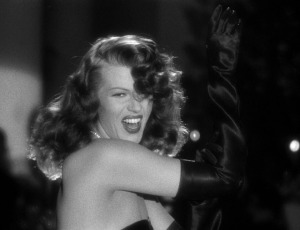 We’re not here to talk about what doesn’t make me cry, however, but what does. I openly admit to incredible sadness every time I watch Gilda (1946), for example. The self-destructive behavior that against all odds (and credulity) results in a happily ever after for Gilda and Johnny doesn’t bring even a single tear. But the incredible beauty and vivacity of Rita Hayworth crushes me because I’ve read about her youth and can only imagine how much pain she was in, as she dealt without professional help with child emotional and sexual abuse, a de-ethnicizing Hollywood makeover, and a stardom that split her life into personal and professional selves. Gilda has too much of Rita, and yet not nearly enough.
We’re not here to talk about what doesn’t make me cry, however, but what does. I openly admit to incredible sadness every time I watch Gilda (1946), for example. The self-destructive behavior that against all odds (and credulity) results in a happily ever after for Gilda and Johnny doesn’t bring even a single tear. But the incredible beauty and vivacity of Rita Hayworth crushes me because I’ve read about her youth and can only imagine how much pain she was in, as she dealt without professional help with child emotional and sexual abuse, a de-ethnicizing Hollywood makeover, and a stardom that split her life into personal and professional selves. Gilda has too much of Rita, and yet not nearly enough.
Yet, that still isn’t what we mean when we talk about tearjerkers, and I haven’t even mentioned the Mrs. Quilliam of the title of this post! All right, then. Let’s get on with it.
SPOILERS AHEAD!
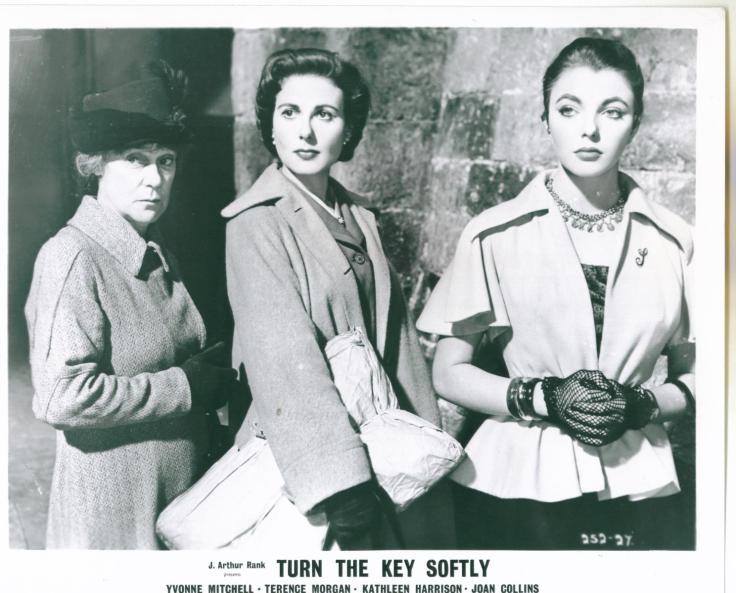
Mrs. Quilliam is the name of an elderly widow and petty thief in in the British noirish-drama Turn the Key Softly (1953), a tale of three women on the day they are released from prison . She is played with unsentimental excellence by Kathleen Harrison (whom I just learned played Mrs. sowerberry in David Lean’s Oliver Twist (1948) and the distasteful Ada Figgins in a 1931 version of Hobson’s Choice, one of my favorite proto-feminist plays). Mrs. Q is released along with well-bred Monica (Yvonne Mitchell), whose love for a handsome criminal (Terrance Morgan’s David, a great example of an homme fatale) led her to assist him in thievery, and beautiful Stella (Joan Collins), who turned to prostitution for money. We follow each woman on her first day out, at the end of which the trio agree to meet for dinner to share their experiences.
For Monica and Stella, the question is whether they will escape return to their past foibles or make new starts. Monica fails to resist the charms of David, and only after being forced to aid him in a heist and escaping while he is taken off by police does she find her way clear. Stella has a fiance, Bob (Glyn Houston), a bus conductor who awaits her release from jail to marry and share a traditional life and home, but she is tempted by easy money. She spends on flashy earrings the little money Bob entrusts her with to rent a room until they can be wed, and then steals from an amorous drunk to replace the money. She too has her happy ending despite the odds, meeting Bob at the end of his shift to live, one assumes, happily ever after…assuming she can handle domesticity.
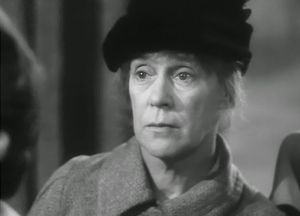 Mrs. Quilliam’s story is different. We learn she can’t wait to get home to Johnny, whom we assume is a boyfriend or at least a potential one. She quickly returns to petty crime, obviously unrepentant. But when we find out how very poor she is and that Johnny is her scruffy, lovable dog, our hearts melt. Or mine did, anyway. She shares the little food she has with Johnny, who has been cared for by grumpy neighbors and a landlady who warns her against any more “trouble.” With no prospects for sustenance, she goes from her flat in Shepherd’s Bush to the well-appointed, middle-class home of her daughter, Lily (Hilda Fenemore). She is especially happy to see her granddaughter, but Lily quickly whisks the child away, telling her mother she has an appointment when it is obvious she finds the old woman’s poverty and crassness distasteful. (This is arguably not unlike the experience of Stella Dallas, and one could wish for a lovely home for the two of them, far away from arrogant, intolerant family members.)
Mrs. Quilliam’s story is different. We learn she can’t wait to get home to Johnny, whom we assume is a boyfriend or at least a potential one. She quickly returns to petty crime, obviously unrepentant. But when we find out how very poor she is and that Johnny is her scruffy, lovable dog, our hearts melt. Or mine did, anyway. She shares the little food she has with Johnny, who has been cared for by grumpy neighbors and a landlady who warns her against any more “trouble.” With no prospects for sustenance, she goes from her flat in Shepherd’s Bush to the well-appointed, middle-class home of her daughter, Lily (Hilda Fenemore). She is especially happy to see her granddaughter, but Lily quickly whisks the child away, telling her mother she has an appointment when it is obvious she finds the old woman’s poverty and crassness distasteful. (This is arguably not unlike the experience of Stella Dallas, and one could wish for a lovely home for the two of them, far away from arrogant, intolerant family members.)
Although I’m not crying by this point, I am feeling low, angry at judgmental others and a society that lets people fall through the cracks so willingly. Mrs. Quilliam is invisible to others except when she steals. Then she is labeled criminal and sent off to prison. All she wants is enough money to get by on, and she has no help.
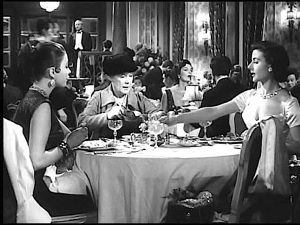 The three women next meet for their elegant dinner, and Mrs. Quilliam even brings Johnny. Her prospects are dim, but so they have been for some time. She does not confide her woes to her friends, instead leaving after the meal to head for her local pub. When she is off to the loo, Johnny manages to run out the door and down the street. Mrs. Quilliam, desperate, runs after him. She looks everywhere, even asking a policeman to help. As a viewer, my heart’s about breaking at this point, and I’m hoping frantically that she finds her one consolation in this life. And then at last she does! Spotting him across a street, she darts out to reach him…and is hit by a car. The first time I saw this, I may have yelled aloud at my TV screen: “Noooo!”
The three women next meet for their elegant dinner, and Mrs. Quilliam even brings Johnny. Her prospects are dim, but so they have been for some time. She does not confide her woes to her friends, instead leaving after the meal to head for her local pub. When she is off to the loo, Johnny manages to run out the door and down the street. Mrs. Quilliam, desperate, runs after him. She looks everywhere, even asking a policeman to help. As a viewer, my heart’s about breaking at this point, and I’m hoping frantically that she finds her one consolation in this life. And then at last she does! Spotting him across a street, she darts out to reach him…and is hit by a car. The first time I saw this, I may have yelled aloud at my TV screen: “Noooo!”
Holding my breath, I keep watching, sure that dear Mrs. Quilliam will be back on her feet and somehow life will get better. Like little Oliver Twist, surely some rich benefactor will save the day. Or at least the driver who hit her will take her home with him and make her well in his stately home, bringing a doctor to mend her, meals in bed, and perhaps even a bit of brandy every now and then. But none of this happens. She is dead.
I’m close to tears by this point, but I’m held back by utter frustration at the cruelty of life, the injustice, the neglect.
Then Monica appears, sadly walking home after David has been taken away by the police. She sees the dead Mrs. Quilliam being put into an ambulance and learns what happened. Now I’m getting sniffly, sad as Monica is at this turn of events.
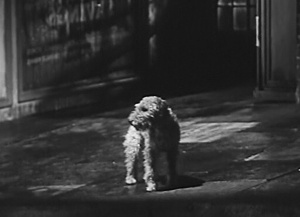 And that’s when Monica sees Johnny, whimpering nearby. And at last a tear falls, followed quickly by others as Monica takes Johnny with her, and you know the two of them will start a new life together.
And that’s when Monica sees Johnny, whimpering nearby. And at last a tear falls, followed quickly by others as Monica takes Johnny with her, and you know the two of them will start a new life together.
Damn these heartbreaking animal videos!

May 12, 2017 at 2:17 AM
This movie broke my heart. So well casted, and a great dog too
LikeLiked by 1 person
May 12, 2017 at 3:27 AM
Yes!
LikeLike
May 12, 2017 at 12:09 PM
Oh! I haven’t even seen this film yet (I will), but you broke my heart.
Kathleen Harrison is a longtime favourite of mine and I am thrilled to discover something new to watch with this actress. Of course, she visits our home every Christmas Eve as Mrs. Dilber in A Christmas Carol. Although I don’t believe she can be found in Lean’s Hobson’s Choice, despite its other excellent attributes.
PS: I am totally with you on Stella Dallas.
LikeLiked by 1 person
May 12, 2017 at 4:39 PM
You’ll love the film and Harrison in it.
And thanks for the correction. Harrison was Ada in a 1931 film version, not the Lean. She was Mrs. Sowerberry in Lean’s Oliver Twist, however. I’ll correct my post!
LikeLike
May 12, 2017 at 6:24 PM
Now I have a 1931 version of Hobson’s Choice to see!
LikeLiked by 1 person
May 13, 2017 at 3:44 PM
Me too!
LikeLike
May 12, 2017 at 12:43 PM
I never would have guessed that the woman who runs a film noir group was such a pushover. Did I ever tell you the story of how my dog died? Anyway, great post!
LikeLiked by 1 person
May 12, 2017 at 4:35 PM
Haha. I’m an emotional gal, it’s true. And no, do not tell me about your dog! I have a cat with cancer and that’s all I can handle right now! 🙂
LikeLiked by 1 person
May 16, 2017 at 3:01 AM
I need to start watching more British noir, because obviously I’m missing out! I like films that are touching but still kind of tough, too. This totally sounds like it fits that criteria.
Thanks so much for contributing to the blogathon!
LikeLiked by 1 person
May 16, 2017 at 3:43 AM
I enjoyed writing this, and I do think you’ll enjoy the film.
LikeLike
November 16, 2017 at 11:23 PM
Not sure why it’s taken me so long to get to this, Salome, but it was worth the wait. I found your account surprisingly moving.
(Yep. So much for my Man of Steel reputation.)
LikeLiked by 1 person
November 17, 2017 at 3:54 PM
Awww, I love this comment.
LikeLiked by 1 person